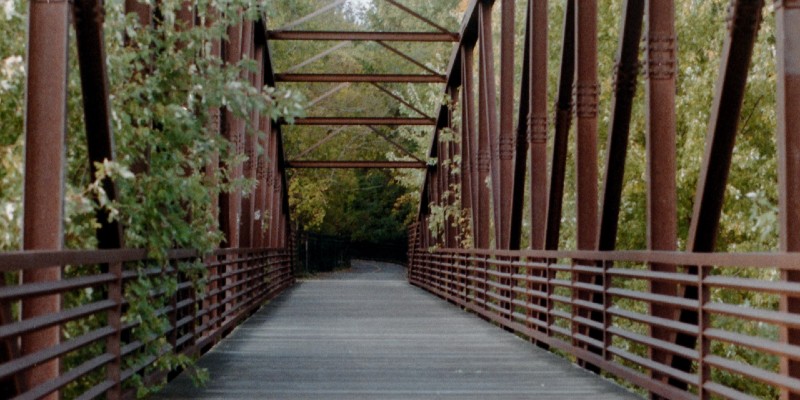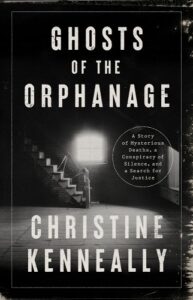It was a freezing day in January 2016 when I passed through a long-locked door and first set foot into what had once been St. Joseph’s Orphanage. The beautiful, spooky old hulk of a building was dark and frigid, and as I walked through the hallways, the sound of my feet against the worn wood floors was amplified in the long corridors.
In the cold winter light, the basement dining room, once an optimistic yellow, had an uneasy green tinge. Here and there the paint blistered. I tried to picture all the children sitting here at their little tables, eating their food and keeping their heads down, dreading the consequences if they got sick.
I walked up the stairs, above the lattice-panel doorway that led to the confessional, past the polished wood posts, past exposed brick and moldering mortar. A dark corridor ran the length of the building, as it did on each of the three other floors. Polished by generations of children, the floor still reflected a dull gleam. To one side opened a room of cupboards, their wooden shelves blanched with dust, the children’s numbers still clearly marked: 53, 19, 34 . . .
After years of talking to former residents and reading their words, I felt like I already knew every nook and corner. Here in the confessional, on one side of the wooden grill, a young boy told a priest that another priest had touched him. The priest’s reaction to this story was angry and dismissive.
Now, I knew, he was also an accused abuser. Here at this bench in a side room, children were pulled in from the corridor and deputized as godparents in quick baptismal ceremonies conducted over abandoned newborns. Here on this floor, a young girl had been forced to troop up and down the hallway, staggering with exhaustion in the middle of the night. Here was the freezing bathroom where a nun swung a girl by her back brace until she bounced off the walls. Here at the elevator door, a girl had clutched each side of the doorway in a mad panic as two nuns behind her tugged her into the small space.
Here, finally, on the top floor, was a pinched, steep staircase caked in dust, and at the top of it, the attic. Every inch of the building below had been assigned a clear purpose. But the vast, eerie attic, with its immense crisscrossing beams and dark rafters, felt almost like a forest, a wild place.
It occurred to me as I stepped nervously across the loft that the Sisters of Providence had probably been frightened of the attic, too. Even when they punished children there, they often went up in pairs. Except maybe for Sister James Mary, who had seemed so energized by rage and hatred and control. Here among the statues and old chests, she had strapped an unhappy teenage girl named Sally Dale into a chair and told her that the chair was electric and would fry her. I stood on the loft and looked around. I tried to conjure up Sally, to see her in the chair. I wanted to tell her that I knew what happened to her. She had not been forgotten. Her words had lived on. But all that was left were echoes and dust.
*
In the fall of 1994, Sally Dale of Middletown, Connecticut, received an invitation in the mail. A two-day reunion would be held at the Hampton Inn in Colchester, Vermont, for “survivors” of St. Joseph’s Orphanage, which struck Sally as an odd word to use. She hadn’t been in touch with anyone from the orphanage for a long time. She thought about the place as little as possible. But she was curious to see some of the old faces and find out who was still around.
Her husband Bob would drive. Bob had looked after Sally since they married and treated her son and daughter from her first marriage as if they were his own. Now that the children were grown, she didn’t have to worry about leaving them as she always had when they were young. She and Bob lived on the ground floor of a triplex, with her son, Rob, and his wife in an apartment above them. When Rob returned late from night shift at the prison, Sally always waited up. She left the front door open a crack and the light turned on. Only when she heard Rob call out, “Good night, Ma!” did she go to bed.
On Saturday, September 18, the first day of the reunion, Sally was only a few steps inside the hotel conference room when a man exclaimed, “You little devil!”
It was Roger Barber, who had been a boy at St. Joseph’s with his two sisters. Little devil, that’s what they used to call her. She hadn’t thought of it in so long.
“Sal, you look good for everything you went through,” one of Barber’s sisters said.
“You were our Shirley Temple of the orphanage!” said the other. She reminisced about the way Sally used to sing “God Bless America” and “On the Good Ship Lollipop” when she was little.
Sally remembered some of those things. She sometimes remembered bad things, too, such as times when the nuns hit her. But it was long ago. She recognized few of the fifty or sixty people in attendance. Debbie Hazen was there, and so was Katelin Hoffman, along with Coralyn Guidry and Sally Miller, but many of those women had lived at St. Joseph’s after Sally left. Some of the women recognized each other not by name but by the numbers that nuns used to identify them: Thirty-two! Fourteen!
The first day’s events began with Philip White, a tall, friendly looking man who explained that he was a lawyer. He introduced Joseph Barquin, who was a resident of the orphanage in the early 1950s, and some other people who were there to help. One man spoke about the Bible and turning to God in times like these, and two therapists said they were available for anyone who wanted to talk. Local journalists were on hand, too.
Sally still remembered some of the little boys she had cared for in the orphanage nursery at that time, but if she had looked after Barquin, she didn’t recall. He stood up and told everyone about a nun taking him into a closet and doing terrible things to him. He still had scars. Roger Barber spoke next. He said that a nun told a group of older boys to rape him. As the morning went on, more of the former residents told their stories, and more of them became increasingly upset. Some began to melt down in the meeting room and the hotel’s hallways. One lanky, weathered man stood up and addressed another man before the whole crowd. He said he had come that day because back in the orphanage he bullied the man. He felt bad about it his whole life and wanted to say he was sorry. Then one woman spoke about how nuns wiped her face in her own vomit, and Sally started to remember that the same thing had happened to her. She could hear the voice of one sister telling her after she threw up her food, You will not be this stubborn! You will sit and you will eat it.
One woman said she’d watched a nun hold a baby by its ankles and swing its head against a table until it stopped crying. As Sally listened to the awful stories, something ruptured inside her. She shook her head and began to say, “No, no, no, no, no, it’s not true.” But it was too late. The spell was broken. Her memories of St. Joseph’s were already flooding back.
Though the reunion would go for two days, Sally could barely stay for one. She left that first afternoon with a crushing headache. Bob drove her home, and the next morning she had diarrhea and was unable to speak without heaving. She had spent that night sitting bolt upright, remembering things she hadn’t thought about for decades, saying, “No, no, no, no, no.” When Bob asked her why she was saying no, she just replied, “No.”
**
More than twenty years later, I met Sally’s son, Rob Dale, in another state, in a tavern at the busy intersection of two highways. The place was loud and a little louche. Rob slid into the large booth of paneled dark wood, placing an old, battered briefcase beside him.
Relief was my dominant emotion. It had taken two years to find Rob. He had worked as a correctional officer for twenty years, specializing in organized crime and intelligence. Now, he kept the details of his life out of the public domain. One of the first things he said to me was that he’d called a lawyer we both knew before he agreed to meet. He wanted to make sure I could be trusted. For all that, he had a lighthearted presence and an open, cheery face. Rob had been worried that I would take his mother’s stories and write about her as if she were crazy. There had been times, he told me, when she told him things that made him think, That’s not sane. In the early 1990s, he started to think she might be going mad. She told him stories from her days at St. Joseph’s Orphanage, and he’d say, “Mom, that doesn’t sound right.” But Sally was adamant. “Bobby, that really happened,” she said. “I’m telling you the truth. This is what happened.”
Rob didn’t exactly disbelieve Sally, but he didn’t want to believe her stories either. He loved his mother and told me how strong she was. She barely reacted if she had a broken bone. It was a kind of strength, to be sure, but also the result of specific training.
“My mother wanted a family so badly,” Rob said. She was loving and always kind to children, welcoming neighborhood kids and baking them cookies. Sally had been odd about food herself. She was particular about her house, too. It was full of happy knickknacks, like small china animals, but everything was always exactly where it was supposed to be. When Rob used to tease her by taking one little item and putting it in another room, she’d notice within seconds of entering. There were other signs that Rob recognized only later. Every summer, Sally took him to a local pond and taught him how to swim. She told him that as a child she’d been thrown into Lake Champlain and told to swim or drown. He was so young himself when she told him that, he said, the extreme nature of the story didn’t register.
I told Rob that when she was very little, Sally was famous in her world for her singing voice. He laughed at the idea. “My mother loved Shirley Temple. She loved her to death! Oh my goodness.” Sally knew all the tunes from all the movies, Rob said. But she’d only hum them. She never sang.
After a few hours, Rob took the briefcase and put it on the table. Sally had given it to him before she died. It contained documents from her fight for justice and letters she had written in the 1990s about everything she saw at the orphanage. It included stories about children that Sally said had died or were even killed at the orphanage. My call had prompted Rob to read Sally’s letters for the first time. He found them painful and intensely moving.
I spent a long time looking for traces of Sally’s life and proof of the stories she told. In the previous few years, I walked through the cemetery she used to hide in. There at that spot, on that gray stone embedded in the soft green grass, that was where she sat. I crossed the black track where the old railway line used to be and wound my way down a steep slope to the shore of Lake Champlain. That was how she made her way to the water to swim. I tracked people all over the country who once knew her or were known by her, or who had once lived the kind of life she had lived. I hunted dates and times and events, and much more elusive, ways to test the veracity of the stories Sally told. Was this extraordinary story, this staggering claim, this insane assertion—was this kind of thing even possible? Did it happen? Could it ever have happened?
I found my way to Sally because for the previous five years I had been talking to people like her. They were mysterious, private, intense voyagers from another realm. Before that point in my life, I’d lived and traveled in different countries. I had a doctorate. I was a mother. I had worked for years as a journalist and thought of myself as a relatively worldly adult. I also believed that the world was a singular, knowable, real place.
___________________________________
Excerpted from GHOSTS OF THE ORPHANAGE: A Story of Mysterious Deaths, a Conspiracy of Silence, and a Search for Justice by Christine Kenneally. Copyright © 2023. Available from PublicAffairs, an imprint of Hachette Book Group, Inc.


















